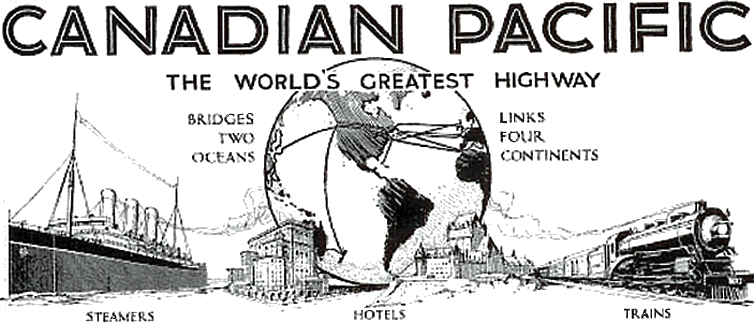 |  History |

The Canadian Pacific Railway Company (CPR) was incorporated in 1881.

It was originally founded to construct the transcontinental railway across Canada, but diversified over time to include hotels, ocean shipping, airlines, mining, and telecommunications to name a few.
Steamship service across the North Atlantic Ocean was to become part of an Imperial Highway known as the "All Red Route" connecting the United Kingdom to Canada and across the Pacific Ocean to British possessions in the Far East.

In 1903 CPR took over the North Atlantic shipping interests of the Elder Dempster & Company and started a trans-Atlantic service.
By 1913 CPR and the Allan Line had teamed up to share food service and stores depots which resulted in their eventual merger.
A fast British subsidized mail and passenger service, hence the RMS (Royal Mail Ship) ship designation, operated on the Quebec City, Quebec, to Liverpool route during summer months with Saint John, New Brunswick, in the winter.
In 1915 Canadian Pacific Ocean Services was formed to operate the combined CPR and Allan Line fleets.
Most of CPR's fleet had been requisitioned by the British Admiralty for war service during World War I.

In 1921 the North Atlantic Fleet name changed to Canadian Pacific Steamships Ltd. based in Liverpool.
Ship passengers bound for the English capital were accommodated by a British Railways boat train named "Empress Voyager" from Riverside Station (Liverpool) to Euston Station in London.
(Liverpool) to Euston Station in London.
The British London & North Western Railway (LNWR) connected Liverpool and London from 1846 to 1922 when it was taken over by the London Midland & Scottish (LMS) until 1948 when the railways were nationalized into British Railways, then privatised.
Worth mentioning is the LNWR once had a unique steam locomotive with the wheel configuration 2-2-2-2 designed for express passenger service.
designed for express passenger service.
In 1939, with the outbreak of World War II, CPR placed all 22 of their ships at the disposal of the British Government with several being used as troopships.
Following the end of the War only 5 remained, 2 were sold, the rest were damaged or sunk.
The 1960s saw a decline in the company's fortunes as a result of increased air travel and the competition from container ships.

By 1968 the shipping operations became known as CP Ships and later CP Ships Inc.
In 1991 the company name was changed once again, finally to Canadian Pacific Ltd.
All CPR ocean services ended when Hapag Lloyd acquired their ships in 2005.
